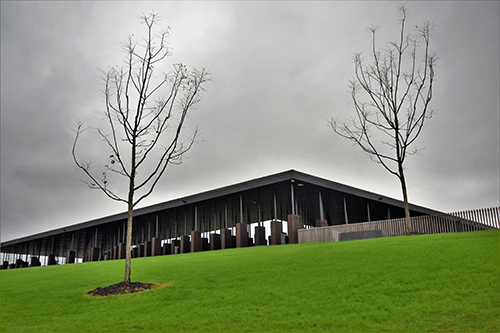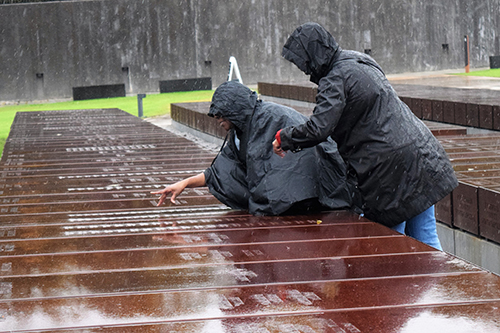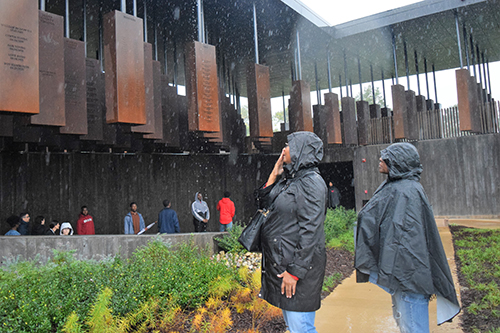
The National Memorial for Peace and Justice sits on a grassy knoll overlooking Montgomery, Ala. — origin of the Confederacy and birthplace of the Civil Rights Movement. The memorial channels the pain, fear and injustice of 4,400 African American men, women and children lynched in 800 counties and 20 states throughout the country including Illinois. Using poetry, historical documentation, design and narratives, a sacred text emerges of human suffering imbued with the power to reconcile our local and national legacy. (PHOTO BY JILL FRIEDMAN FOR COMMUNITY WORD)
BY PAM ADAMS
The new lynching memorial in Montgomery, Ala. is a prayer and a challenge.
The memorial, officially the National Memorial for Peace and Justice, is the end of a public eulogy, in stone and steel, for the long-buried memories of thousands of Black people killed by white mobs during the decades when racial terror was routine.
Rows and rows and rows of hanging coppery-colored steel columns, each engraved with counties, states and the name or names, if known, of Black men, women and children lynched in that county — 805 hanging gravestones memorializing more than 4,000 lynchings documented from 1877 to 1950, almost 60 in Illinois.
Everything about the 6-acre space feels like a call to rise up in the name of each life. A sacred psalm comes to mind. When mercy and truth meet, righteousness and peace kiss, and justice is merciful.
• • •
The structure is a wide-open shelter on a hill near downtown Montgomery, not far from the water fountain in the town square where the enslaved were once sold from the auction block. Not far from where the Confederacy was born. Not far from where Rosa Parks refused to sit in the back of the bus, not far from where the old segregationist governor George Wallace vowed segregation now and forever. Not far from where the massive, blood-stained, 54-mile march from Selma to Montgomery ended with the triumphant, yet vigilant, words of Martin Luther King.
“How long? Not long,” King said that day in 1965, the question edged with the hope that has hung over the nation since the founding fathers compromised on slavery.
None of the sites is far from the Equal Justice Initiative, a non-profit human rights law office founded by Bryan Stevenson, a defense lawyer called the Mandela of our times for his work with the condemned, the wrongfully convicted, the poor.
Why would a law firm build a lynching memorial and a museum?
Because defending the poor, even winning major death penalty cases, cannot explain how a vaunted democratic nation came to be the country with the highest rate of incarceration in the world, higher than Russia, higher than China. And so when EJI conceived the memorial, it built a teaching museum. They opened together in April. In words, images and interactive exhibits, the museum details the legacy. Modern-day policing and mass incarceration are direct descendants of slavery, segregation and a culture that presumes white people are superior, Black people are guilty. The museum’s full name is The Legacy Museum: From Enslavement to Mass Incarceration.”
“Slavery did not end in 1865,” Stevenson has said repeatedly. “It evolved.”
Add one more point to the legacy the museum details. The death penalty is a direct descendant of lynching.
• • •

Cold rain falls as Pam Adams and Sherry Cannon point to names on a memorial duplicating those etched on hanging columns in the National Memorial for Peace and Justice. More than 4,400 lynched African Americans are recognized in the memorial. These duplicate columns can be obtained by the 800 counties across America where lynchings took place. To obtain the memorial, each county must commit to documenting its racist historical narrative. The goal is to reconcile the past in order to achieve a more just future. (PHOTO BY JILL FRIEDMAN FOR COMMUNITY WORD)
The six-foot steel slabs at the lynching memorial begin at eye-level. County by county, state by state, death by death, the slabs rise, higher and higher until they hover overhead, like so many bodies once did.
Somewhere near the middle of the curving path of hanging steel, the lesson hits home. A legacy of lynching in the Land of Lincoln is not that far from the lynching legacy in the cradle of the Confederacy. Even in Illinois, a 100-year history of legal slavery did not truly end until 1863, two years before the end of the Civil War. And Illinois only ended the death penalty after a series of wrongful convictions exonerated men imprisoned on death row.
Four slabs mark Illinois’ legacy of lynching and racial terrorism. One is devoted to the dozens of Black men, women and children shot, burned or beaten to death by white mobs in the East St. Louis race riots in 1917. Another is a roll call of lynchings from one end of the state to the other. Though most lynchings in Illinois occurred in the southern part of the state, the memorial also documents lynchings in or near Lacon, Lewistown, Decatur and Springfield during the infamous race riots of 1908, which led to the founding of the NAACP.
“We would hear stories as kids,” say Michael McCuskey, a long-time judge who grew up in Sparland. He didn’t know if the stories were truth or legend, but he remembers hearing blacks had to be out of Lacon by sundown and something about a lynching on a hill just outside Lacon.
There is a name and a date at a lynching memorial more than 700 miles away, bearing witness to a lynching just outside Lacon in Marshall County in 1898.
Peoria County barely escaped a place on one of the columns devoted to Illinois lynchings. In “The History of the Negro in Peoria,” Romeo B. Garrett, Bradley University’s first Black professor, describes two near-lynchings of Black men more than a century ago.
But southern lynchings and racial terror played a part in changing Peoria. The city’s Black population ballooned more than 200 percent from the 1940s to the 1960s. Economic opportunity isn’t the only reason African-Americans fled the South for northern cities during the Great Migration from the 1800s to the 1960s.
One of the most horrific lynchings memorialized at the lynching memorial, the spectacle lynching of Jesse Washington in 1916, occurred in Waco, Texas, where my mother was born, where my grandparents and Waco’s close-knit Black community must have known the victim’s family, must have experienced the terror. Hinds County, Miss., where my father’s family comes from, was one of the most lynch-happy counties in a state with the nation’s record for highest number of lynchings.
Sherry Cannon, who visited the memorial with me, left with the nagging thought that a name listed as a lynching victim in Pike County, Mo., her family’s hometown area, might be a distant relative.
• • •
Robert T. Little has not visited Montgomery’s new museum and memorial. Born in Mississippi, raised in Peoria, Little grew up carrying the collective memory of generations who fled the South, the same memories and messages unearthed at the lynching memorial and Legacy Museum.
“My dad showed me the hanging tree,” he said.
Little, 74, was in his 20s at the time. He had gone South with his father, the late Frank Little Jr., on one of the family’s regular trips down home to Cruger in Holmes County, Miss. It was a big, thick tree, Little recalls, in an isolated spot on the side of a road.
“If something happened, they didn’t care who they hung. It didn’t have to be the right one. They’d just hang them and leave them up in the tree. That’s the way they kept Blacks under control,” Little says.
Controlling Black life had been a hallmark of slavery. By the time Little’s father was born in 1919, racial segregation, racial terrorism and lynching were the new tools of a country steeped in white superiority.
“There were some things he didn’t tell me,” Little said, knowing silence was his father’s way of protecting him from pain, trauma and, most of all, anger.
• • •

Sherry Cannon, left, gasps as she and Pam Adams read the names of some of the 4,400 victims of lynching etched onto 800 corten steel beams hanging at the National Memorial for Peace and Justice. The memorial, referred to as “the lynching museum,” documents racial terror and inequality in America in a way never before acknowledged and provides a silent, sacred place for reflection, truth and reconciliation. (PHOTO BY JILL FRIEDMAN FOR COMMUNITY WORD)
A rainy day is appropriate for a visit to a memorial dedicated to African-Americans lynched not so long ago, not so far away. Raindrops wash down like tears for all the years the meaning of their deaths went unnoticed, ignored, distorted.
If the Legacy Museum tells how we got here, the lynching memorial offers the first stage of a prescription for what to do next.
Replicas of each steel column lie in the grassy knoll on the memorial grounds. They are waiting to be claimed, waiting to go home to the towns and villages where the lynching and terror took place.
A history of racial injustice haunts the country, Stevenson, the author of a best-selling memoir, “Just Mercy” has said. Slavery evolved into decades of terrorism and violence, “a shadow that undermines so many of our best efforts to get to something that looks like justice.”
Healing begins with confronting the ghost of history, he says, similar to the truth and reconciliation efforts of Germany after the Holocaust or South Africa after Apartheid.
Communities that want to claim a column must show they’re willing to dig into their pasts and plant the seeds for a future of justice, equality and mercy.
How far? Not far . . . .
Pam Adams can be reached at padams281@gmail.com
For more information go to: lynchinginamerica.eji.org

Recent Comments